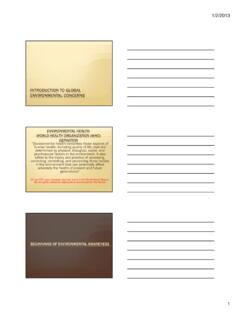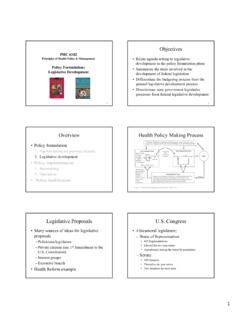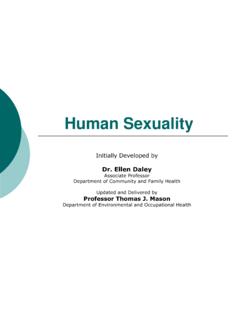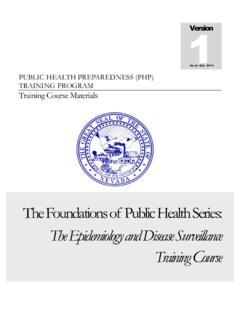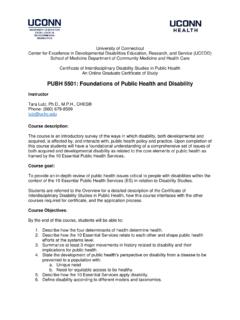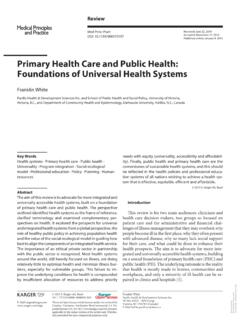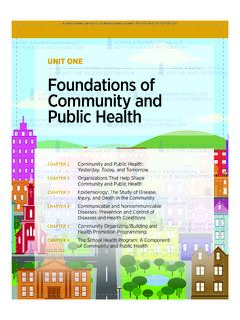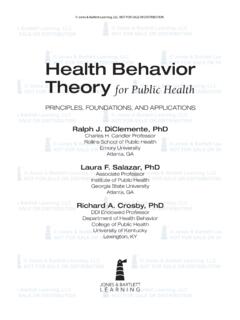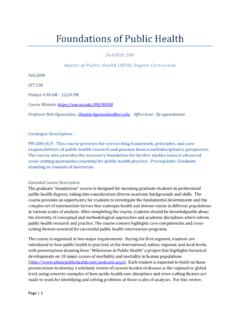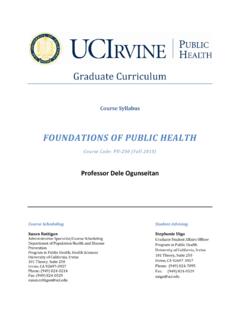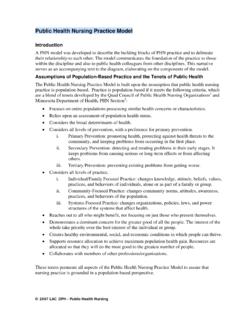Transcription of Foundations of Public Health Immunology
1 1 Foundations of Public Health ImmunologyInnate Immunity,Inflammation & Nutrition2 ObjectivesIdentify principles of innate immunityIdentify receptors and responses of innate cells to microbes (alert system)Describe & identify examples of the 4 types of innate defensive barriersIdentify the cardinal signs of inflammationIdentify the differences between acute and chronic inflammationIdentify components of inflammation & how they enhance immunityUnderstand role of nutrition in immune response & identify examples of nutrient deficiencies3 Earliest Immune SystemInnate immunity refers to the basic resistance to disease that a species may possess Phylogenetically ancient defenseInvertebrates & vertebrates both have components of innate immunity (complement, receptors)Only vertebrates contain adaptive responsesSource: of Innate Immunity Also known as Natural or Native immunity Provides general resistance to antigensNot specificfor any given pathogen or antigenProvides a rapidresponse to antigensNo memoryResponse does not improve with successive exposures to the same pathogen or antigen5 Time is of the Battle BeginsA microbe enters the does the innate system detect it?
2 How does the innate system tell the rest of the body that there is a problem? 7 All About the Receptors: RecognitionInnate response is not completely non-specific after allIt recognizes PAMPs(Pathogen Associated Molecular Patterns)Toll-like receptors & Mannose receptorsare part of our cellular membranes that recognize these PAMPs ( LPS, mannose sugars on microbes)Receptors then send signalsto the cell that a pathogen has entered & to turn up the immune response (alert- there is a problem!)Watch this animation that shows how TLRsrecognize a virus to protect the body. Read this brief NY Times article on the therapeutic history of Toll-like receptors and how drug companies are now using Toll-like receptors as designer drugs. 8 Bodily Harm Warning: Microbe Alert!Watch this short flash animation that shows the activation of the immune cell as it responds to LPS binding to a Toll-like receptor.
3 9 Innate Defenders: OverviewFour types of defensive barriers: anatomic (skin, mucous membranes)physiologic (temperature, pH, oxygen tension) phagocytic (macrophages, neutrophilsingest molecules) inflammatory (vasodilatation, capillary permeability) Watch a quick flash animation of how innate immunity defends against microbes @ Innate Immune System10 Defensive Barriers: AnatomicSkin:major organ barrier (physical) against external organismsNormal flora prevents colonization, constant sloughing of dead skinLow pH and lysozyme are anti-microbialMucous membranes:protects respiratory, genitourinary (GI), & urogenital tractsCiliated epithelial cells, mucous, tears, & saliva transport or kill microbes before they can colonize the body11 Defensive Barriers: AnatomicMucous membranes:Chemical:mucous traps or prevents microbial attachment to cellsEnzymes:lysozyme degrades G+ cell wall and is present in tears proteases destroy cell membrane of G- bacteria & viral envelope coats12 Defensive Barriers: PhysiologicFever:pathogens grow at specific temps, and fever raises the body temperature above the preferred rangepH:low pH in stomach, skin, vagina prevent infectionOxygen tension:skin wounds can lead to a decrease in localized tissue perfusion & hypoxiaEarly innate immune system responds to hypoxia by activating nitric oxide synthase & inflammatory cytokines in wound13 Defensive Barriers.
4 PhagocyticLiteral translation of phagocytosis is eating cellSpecialized phagocytic cellsMacrophages & NeutrophilsCell membrane folds in (endocytosis) & internalizes microbe to form a phagosomeFusion with lysosome + enzymesIntracellular killingwith lysosomal enzymes, reactive oxygen intermediates (ROIs)14Go to the Cells Alive website to read about the oxidative burst! ROI reaction shown + AdaptivePhagocytic cells are linked to adaptive responsesProduce cytokines, costimulators that target T cells (enhanced agpresentation)16 Defensive Barriers: InflammatoryMacrophages release cytokines & ROIsthat stimulate inflammationNeutrophils also stimulate macs & release ROIs to increase inflammationInflammation enhances the immune responseVasodilation & capillary permeability allow leukocyte migration to sites of tissue injurySource: (-itis)The body s reaction to invasion by an infectious agent, antigenic challenge or physical damageNONSPECIFIC responseMajor goal is to allow products of immune system into area of infection or damageWatch this brief intro video to inflammation: Is it a good thing or a bad thing?
5 Beware: swollen feet!18 InflammationAcute InflammationTemporaryresponse to transient injuryMay develop into chronic inflammationExudative responseChronic inflammationSustained reaction to persistent injurious stimulusProliferative response(involving cell-mediated immunity)Granuloma formation may occur1920 Cardinal Signs of Acute Inflammation1. Rubor: redness2. Calor: heat3. Dolor: pain4. Tumor: swelling5. Functio laesa: loss of functionClick through these slide shows on Acute Inflammation & Cardinal Signs to see images of the cardinal signs of inflammation. Image Source: Nature Reviews Immunology2, 787-795 (2002); LIPID MEDIATORS AND INSIGHTS INTO THE RESOLUTION OF INFLAMMATION2122 Inflammatory Components1. Blood supply changesIncreases to bring cells and large molecules to area2. Capillary permeability changesIncreases to allow exudation of serum protein3. Leukocyte migrationIncrease into affected area across venules23 Blood Supply Increase (1)24 Transudate Low protein Few cells Hydrostatic pressureExudate High protein (Ab) Many cells Increase permeabilityNormal lymph (without injury)TransudateDilation increases blood flow in arterioles and capillaries, high pressure fluid Lymph (with injury)ExudateIncreased permeability in venules, large molecules and cells escape into damaged tissueCapillary Permeability Changes (2)25 Leukocyte Migration (3)Watch an animation of how immune cells moveto the site of injury, as they roll & stick to the endothelial cells lining the vessels, before squeezing out into the tissues.
6 26 Cell MigrationLeukocyte migration across endothelium depends upon:surface charge of the interacting cells (occurs where lowest)hemodynamic shear force in vascular bed (occurs where lowest)expression of adhesion molecules on leukocytes and endotheliumPattern and purpose of migration depends upon the cell type, state of differentiation and activationEnsures that APCs, lymphocytes and antigen converge upon secondary lymphoid tissue, lymph nodes, or spleen to produce an immune response, or upon sites of inflammation 27 Cells travel to infxn site to destroy (4)28 Microbial Evasion StrategiesSome bacteria have developed ways to defeat innate immunityResist phagocytosis, ROIs to avoid death29 Role of Nutrition in ImmunityNutrition is a key element to a healthy immune system Vitamin deficiencies have been shown to decrease immune functionAnd, lead to increased infections30 Extremely Brief Review of HUMAN NUTRITIONFOOD is a mixture of chemicals NUTRITIENTS are the essential chemicals in foods6 classes of nutrients found in food: 1.
7 Carbohydrates2.) Lipids3.) Proteins4.) Vitamins5.) Minerals6.) Water31 Macronutrients vs. MicronutrientsMacroNutrients such as carbohydrates, fat, or proteins, that are needed in relatively large amounts in the dietsMicroNutrients such as a vitamin or mineralthat is needed in relatively small amounts in the dietEnables body to produce enzymes, hormones & other substances essential for proper growth and developmentVitamins A, C, D important to properly functioning immune systemZinc & ironFruits & Veggies are important sources of nutrients, especially micronutrients. Photo by Peggy Greb, USDA Image Number : The Silent CrisisDefinition:Failure to achieve nutrient requirements which can impair physical and/or mental healthMay result from consuming too little food or a shortage/imbalance of key nutrients Several types:Protein-energy malnutrition (PEM) Kwashiorkor MarasmusMicronutrient deficiencies (Vitamins A, C, D)Mineral deficiencies (Zinc, Iron)33 Protein-Energy Malnutrition (PEM)Most widespreadform of malnutritionPrevalent in Africa, Central & South America, EastCondition of infants and childrenDevelops after children are weaned from the breastMicronutrient deficiencies linked to development of PEMW idespread atrophy of lymphoid tissues& 50% reductionin circulating CD4+ T cells34 MarasmusA type of malnutrition resulting from chronic protein-energy under nutritioncharacterized by wasting of muscle and other body tissuePhysical term for starvationOften occurs after child weaned from breast milk35 KwashiorkorType of malnutrition that occurs primarily in young children who have an infectious diseaseDiets supply marginal amounts of energy and very little protein (carbs )
8 Common symptoms include poor growth, edema, apathy, weakness, & susceptibility to infectionsDiarrhea & anemia compound problemKwashiorkor: edema from hypoalbuminemia36 Vitamin AVitamin A needed for Vision (night, day, colour) Epithelial cell integrity(against infections) in skin, mucous membranes Immune response Haemopoiesis Skeletal growth Fertility (male and female) Embryogenesis Keratomalacia, damage shows a softened hyperkeratotic epithelium and may thus become secondarily infected. 37 Vitamin A DeficiencyMore than one million children a year die as a consequence of a number of diseases precipitated by VADAll developing countries affected by multiple micronutrient deficiencies, but vitamin A highly impacts Africa and SE Asia38 Vitamin A DeficiencyVAD prevalent among poor who depend mainly on rice as daily energy source (400 million) Rice does not contain -carotene (provitamin A)
9 Most severely affects children and pregnant women Compromises immune systems of ~40% of children <5 Predisposes infants and children to diarrheal disease Usually co-existing with PEM250,000 to 500,000 children to go blind every year More than half also die within a year39 Vitamin CVitamin C helps maintain the redox integrity of cellsProtects against reactive oxygen speciesgenerated during respiratory burst and in the inflammatory responseShown to reduce the duration and severityof colds (Mom is right- drink your Orange Juice!)Vitamin C supplementation improves immune function: Antimicrobial and natural killer cell activitiesLymphocyte proliferationChemotaxisDelayed-type hypersensitivityVitamin C modulates host resistance to infectious agents, by reducing risk, severity and duration of infectious diseases40 Vitamin DHumans make Vitamin D in skin-need sunlightAlso produced by activated macrophagesVitamin D is an important immune regulatorDeficiency results in overactiveresponse & has been linked to some autoimmune diseases41 Zinc & IronZinc important to biological activity of thymus hormonesDeficiency results in decreased cell-mediated immunityImpairs phagocytosis, NK cell activity, and generation of oxidative burstIron extremely important to cellular functions & oxygen transportDeficiency impairs oxidative burstin neutrophils42 Malnutrition and InfectionTwo causal pathways1.
10 Infection leads to malnutrition2.) malnutrition increases susceptibility to infectionsDifficult to resolve, pathways may occur concurrentlyNutrition improves immunity- eat a balanced diet!43 Summary of Innate ImmunityUnderstand principles of innate immunityInnate receptors & signaling networksFour innate defensive barriers4 stages of inflammation after tissue damageRole of nutrition in immune responseSpecific examples of vitamin deficiencies & immune function44 Self-Test QuestionsName 2 characteristics of innate immunity (principles).How does the innate immune response recognize pathogens?What are the 4 types of defensive barriers? Give an example of each is the difference between acute & chronic inflammation?What are the 5 cardinal signs of inflammation?What are the 3 major components of the inflammatory response?How does nutrition influence the immune response? Give 2 examples of the impact of vitamin deficiencies on immunity.

